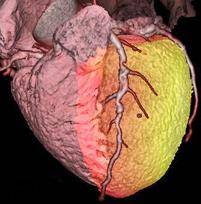Myocardial Perfusion Scintigraphy

We offer state-of-the-art myocardial perfusion SPECT imaging using a novel, dedicated cardiac system with solid-state detectors which enables faster imaging at lower radiation doses.
Sharir, T. et al. Multicenter trial of high-speed versus conventional single-photon emission computed tomography imaging: quantitative results of myocardial perfusion and left ventricular function. J Am Coll Cardiol 55, 1965-1974 (2010). S Ben-Haim, et al. Simultaneous dual-radionuclide myocardial perfusion imaging with a solid-state dedicated cardiac camera. Eur J Nucl Med Mol Imaging 37, 1710-1721 (2010).
Myocardial Perfusion PET
Myocardial perfusion PET using Rubidium-82, enables faster imaging at lower radiation doses even in patients with high BMIs. It is often combined with CT coronary angiography to provide both perfusion and anatomy in a hybrid imaging test.
Groves A.M. et al. Cardiac 82Rubidium PET/CT: initial European experience. Eur J Nucl Med Mol Imaging 2007 Dec;34(12):1965-72.
Groves, A. M. et al. First experience of combined cardiac PET/64-detector CT angiography with invasive angiographic validation. Eur J Nucl Med Mol Imaging 36, 2027-2033 (2009).
Menezes, L. J. et al. Assessment of left ventricular function at rest using rubidium-82 myocardial perfusion PET: comparison of four software algorithms with simultaneous 64-slice coronary CT angiography. Nucl Med Commun 30, 918-925 (2009).
Myocardial Viability PET imaging
Myocardial viability PET imaging with FDG helps predict functional improvement before revascularization.
CT Calcium scoring
Calcification of the coronary arteries is a sign of atherosclerotic disease and can be quantified using multi-slice computed tomography (CT). We provide same day calcium scoring as the Rapid Access Chest Pain Clinic to rule out coronary artery disease in low risk patients.
CT coronary angiography
CT coronary angiography Is provided for patients with suspected CAD, to evaluate disease progression, and to establish the need for revascularization. CT can also be used to assess the function of the heart, the anatomy of the heart, and the degree of coronary calcification in the heart.
Groves, A. M. et al. CT coronary angiography: quantitative assessment of myocardial perfusion using test bolus data-initial experience. Eur Radiol 18, 2155-2163 (2008).
 Close
Close

